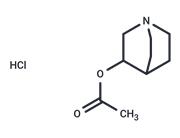| Name | Phenoxybenzamine hydrochloride |
| Description | Phenoxybenzamine hydrochloride (NCI-c01661) is the hydrochloride salt form of phenoxybenzamine, a synthetic, dibenzamine alpha-adrenergic antagonist with antihypertensive and vasodilatory properties. Phenoxybenzamine non-selectively and irreversibly blocks the postsynaptic alpha-adrenergic receptor in smooth muscle, thereby preventing vasoconstriction, relieving vasospasms, and decreasing peripheral resistance. Reflex tachycardia may occur and may be enhanced by blockade of alpha-2 receptors which enhances norepinephrine release. Phenoxybenzamine is reasonably anticipated to be a human carcinogen. |
| Cell Research | Phenoxybenzamine hydrochloride is dissolved in DMSO. After cytometry, 1×3 cells are implanted in a 96-well plate in 100 μL DMEM supplemented with 10 % FBS. Ten microliter (10 % of the total volume) WST-1 (Water Soluble Tetrazolium) is added to cells and incubated at 37°C for 30 min before colorimetric assay with 450 nm excitation and 630 nm emission at 24 h intervals up to 96 h. The mean fluorescence value is counted, and the cell number is determined using the standard curve. |
| In vitro | The IC50 (100 nM) derived from the blockade of [3H]yohimbine binding by Phenoxybenzamine hydrochloride is significantly less than the IC50 (550 nM) for the corresponding reversal by Phenoxybenzamine hydrochloride of the effects of norepinephrine on cyclic AMP accumulation[1]. Phenoxybenzamine hydrochloride (50 nM) in conbination with Phenoxybenzamine hydrochloridetolamine (1000 nM) enhances Phenoxybenzamine hydrochlorideylephrine-induced contraction compared with pretreatment with Phenoxybenzamine hydrochloride (50 nM) alone in endothelium-intact aortae. Combined treatment with either dexmedetomidine (300 or 1000 nM) and Phenoxybenzamine hydrochloride (50 nM) or Phenoxybenzamine hydrochloridetolamine (1000 nM) and Phenoxybenzamine hydrochloride (50 nM) enhance Phenoxybenzamine hydrochlorideylephrine-induced contraction compared with Phenoxybenzamine hydrochloride alone (50 nM). In addition, combined treatment with Phenoxybenzamine hydrochloridetolamine and Phenoxybenzamine hydrochloride enhances Phenoxybenzamine hydrochlorideylephrine-induced contraction compared with dexmedetomidine (1000 nM) and Phenoxybenzamine hydrochloride combined treatment. Combined treatment with high concentrations of dexmedetomidine (1000 nM) and Phenoxybenzamine hydrochloride enhances Phenoxybenzamine hydrochlorideylephrine-induced contraction compared with combined treatment with low concentrations of dexmedetomidine (300 nM) and Phenoxybenzamine hydrochloride[2]. |
| In vivo | Phenoxybenzamine hydrochloride (20 nM, s.c.) effectively suppresses the tumorigenesis of glioma cells in mice and the cell density in Phenoxybenzamine hydrochloride-U87 mg xenografts decreases significantly[3]. Phenoxybenzamine hydrochloride (1 mg/kg, i.v.) treated rats shows significant improvements in NSS and foot fault scoring[4]. |
| Storage | Powder: -20°C for 3 years | In solvent: -80°C for 1 year | Shipping with blue ice/Shipping at ambient temperature. |
| Solubility Information | Ethanol : 63 mg/mL (185.13 mM), Sonication is recommended.
10% DMSO+40% PEG300+5% Tween 80+45% Saline : 2 mg/mL (5.88 mM), Sonication is recommended.
H2O : 14 mg/mL (41.14 mM), Sonication is recommended.
DMSO : 55 mg/mL (161.62 mM), Sonication is recommended.
|
| Keywords | α-adrenergic receptor | pheochromocytoma | Phenoxybenzamine Hydrochloride | Phenoxybenzamine hydrochloride | Phenoxybenzamine | NSC-37448 | NSC37448 | neuroprotective | Inhibitor | inhibit | hypertension | glioma | CAM | Beta Receptor | antitumor | AdrenergicReceptor | Adrenergic Receptor |
| Inhibitors Related | Olanzapine | Mirtazapine | Octopamine hydrochloride | Buflomedil hydrochloride | Dexmedetomidine hydrochloride | Phenylephrine hydrochloride | Amitriptyline hydrochloride | Isoprenaline hydrochloride | Melatonin | Nifedipine | Trazodone hydrochloride | Mianserin hydrochloride |
| Related Compound Libraries | Highly Selective Inhibitor Library | Bioactive Compound Library | Anti-Neurodegenerative Disease Compound Library | Membrane Protein-targeted Compound Library | Kinase Inhibitor Library | Drug Repurposing Compound Library | Inhibitor Library | Anti-Cancer Approved Drug Library | FDA-Approved Drug Library | Bioactive Compounds Library Max | Anti-Cancer Active Compound Library | Anti-Cancer Drug Library |

 United States
United States






